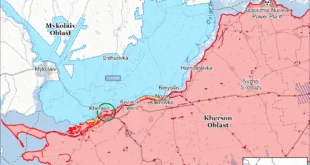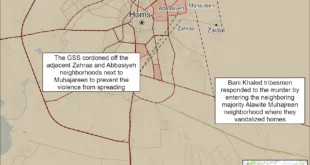Officials in Tehran have a lot to worry about. But they are particularly irked at the speed by which Asian states have dropped Iran as a trading partner. Iran had hoped that the East would save the country’s economy from the barrage of sanctions enacted by the administration of U.S. President Donald Trump. In early 2018, at a time when Trump and his team were about to unveil the most punishing sanctions regime ever imposed on a country, Supreme Leader Ali Khamenei explicitly urged Tehran to look east for trading partners. Khamenei’s track record in vilifying the West is lengthy, with the ayatollah regularly scorning any official in Tehran who disagreed as a simpleton or “unreasonable.” But his alternative has so far proved to be nothing but a pipe dream. Even so, Khamenei maintains the charade of a promised bailout.
Over the course of the Trump presidency, Iran’s relations with Asian countries have varied, but there is no sign of a clear success anywhere. Among the country’s big former trading partners, South Korea and India stand out as the most eager to respect U.S. sanctions on Iran. They stopped buying Iran’s oil, halted any long-term investments they had in Iran, and more or less refuse to sell anything to the country. In June, after two years of negotiations, South Korea finally sent to Iran a cargo of humanitarian goods worth $500,000. Another shipment worth $2 million is said to be under way, but only if Seoul first secures the approval of Washington.
Tehran is also livid that Seoul is still blocking payments of some $7 billion for oil that was exported to South Korea before U.S. sanctions were implemented in late 2018. Iranian media are full of headlines demanding not only that Koreans pay up but also that they hand over maintenance fees for having kept the money in two South Korean banks. Iranian President Hassan Rouhani has asked his government take legal action against Seoul to deter other countries from behaving the same way.
Iran’s protestations have had few results. When in 2019 the South Korean companies Samsung and LG announced that they would stop operating in Iran, officials in Tehran warned them that coming back to the Iranian market might not be so easy. “Commercial logic dictates that keeping a market is easier than reentering a market once you leave,” said one. Still, the South Koreans left. Although Iran does represent a big market, of course, the United States represents a bigger one.
South Korea is not alone. Take India. New Delhi has in recent years rebuffed Tehran at every critical turn. When the Trump administration first reimposed sanctions on Iran in 2018, the Indians first sought to push for a hard bargain with Tehran. India has historically had a large trade deficit with the country. In 2018, for example, its imports amounted to around $13 billion from Iran, but its exports were worth merely $3 billion. New Delhi was looking to address that imbalance. The Indians offered a barter of oil for goods. It was a major setback for Tehran, since such an arrangement would have deprived it of much-needed foreign currency exchange. In the end, U.S. pressure was impossible for the Indian government to resist, and it basically cut Iran loose altogether.
The United States had even given New Delhi a waiver so it could continue as an investor and operator in the development of Iran’s deep-sea port at Chabahar on the Gulf of Oman, but the Indians still dragged their feet on that project. Chabahar has long been touted as India’s strategic conduit to markets in Afghanistan and in Central Asia and as a regional counter to the Chinese-sponsored port of Gwadar in Pakistan. But India had second thoughts, and Tehran’s anger was palpable. In retaliation, Khamenei himself has begun to issue criticism of Indian policies in Kashmir, a conflict he had in the past largely ignored.
Among Iran’s other top trading partners in the East, Japan and China stand out for different reasons. In the case of Japan, Tokyo swiftly ended trade with Iran in compliance with U.S. sanctions. Still, the government, as former National Security Advisor John Bolton’s new book underscores, was at the same time happy to play a possible mediator role between Tehran and Washington. Since Japan is a top U.S. ally, Tehran never held out much hope for maintaining trade with Tokyo, but it seemed to genuinely appreciate Japanese efforts aimed at a diplomatic resolution. This was evident in Rouhani’s decision to pay a state visit to Tokyo in December 2019, the first by an Iranian president since 2000. Even as Japanese mediation failed to result in a breakthrough, Tokyo’s handling of the U.S.-Iranian standoff stood out as rather skillful diplomatic navigation.
Meanwhile, in Tehran’s eyes, China has ranged from being a potential silver bullet to the mother of all disappointments. In May 2019, Foreign Minister Mohammad Javad Zarif visited China on a two-pronged mission. Zarif asked Beijing to help save the Iran nuclear deal of 2015, which the Trump administration left in May 2018. He also pushed the Chinese to continue to buy Iran’s oil and ignore U.S. sanctions. At first it looked like Zarif’s message had been well received. As he was in Beijing, it was reported that a tanker with Iranian oil had delivered its cargo to a Chinese port. This was the first time Iranian oil arrived in China since the Trump administration put a total ban on all Iranian oil exports starting in late 2018.
Just a few weeks before, at the January 2019 Munich Security Conference, Zarif had admonished the Europeans for abandoning trade with Iran under U.S. pressure. The Europeans had that month launched Instex, a mechanism to facilitate trade with Iran, but it was already clear that European investors and firms were rushing out of Iran. Only China could be Iran’s economic savior—or so the thinking went in Tehran. In fact, for the year 2019, Iran-China trade dropped by one-third to a total of around $23 billion. Both Iran and China are exporting less to each other.
The alarming data was revealed at a time when the Iranian public was already increasingly anti-Chinese due to the coronavirus, which had arrived in Iran from China sometime in late 2019. The state of affairs became so tense that China’s ambassador to Tehran, Chang Hua, had to write an open letter. He explained that the downturn in trade was due to the COVID-19 crisis in China and that it would be temporary. Since then, the Chinese ambassador has periodically reminded the Iranian public that China has long-term strategic plans for Iran and said that it is bound to be a country that will eventually dominate the global economy.
Still, while China has a strong protector in Tehran in Khamenei, there are official voices within the ranks of the ruling class that question the logic behind Iran putting all its eggs in the Chinese basket. Iran’s dependence on Beijing is creating tough questions about Tehran’s inability to risk offending its partner. And yet, the two institutions most dedicated to China in Iran are the Office of the Supreme Leader and his armed foot soldiers in the Islamic Revolutionary Guard Corps, the two most significant centers of power in the country. This is why China feels comfortable in its position as Tehran’s matchless foreign partner.
There is no doubt that Iran’s relationship with China is bigger than mere trade. As was evident in China’s vote against censuring Iran at the International Atomic Energy Agency on June 19, Iran and China have a multitiered engagement. Most notably, each see the other as a card to be played in their respective tugs of war with the United States. But even in the unlikely event that Beijing comes through for Iran in saving its economy from U.S. sanctions, this would not be tantamount to a successful Iranian anchor in the so-called East as Khamenei has for years advocated. It is more a case of subjugation to China and its interests. There is otherwise no sign of a working Iranian policy toward the East. There are plenty of analysts and commentators in Tehran who recognize this hard reality, but very few are willing to stick their necks out and say so publicly and loudly. After all, self-censorship is a way of life for Iranian officials, and very few of them dare to question the purported wisdom of Ayatollah Khamenei’s much-coveted pivot to the East.
 Eurasia Press & News
Eurasia Press & News



